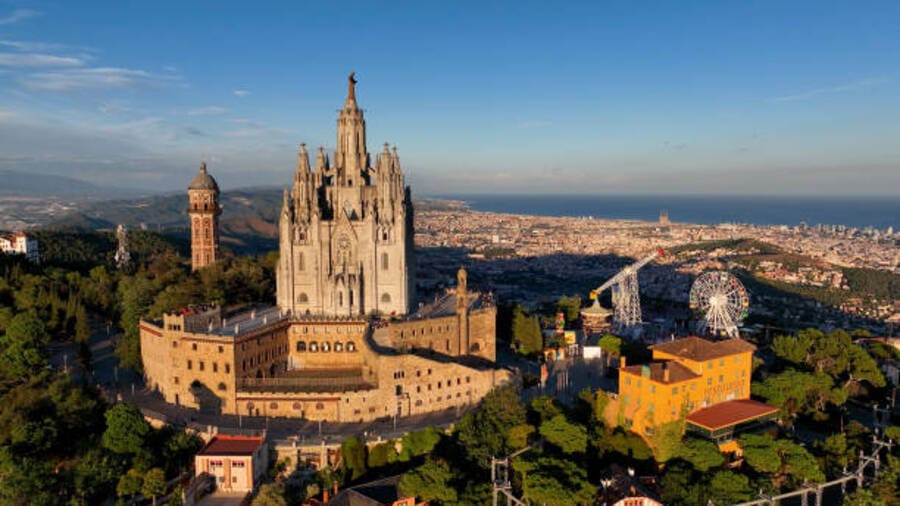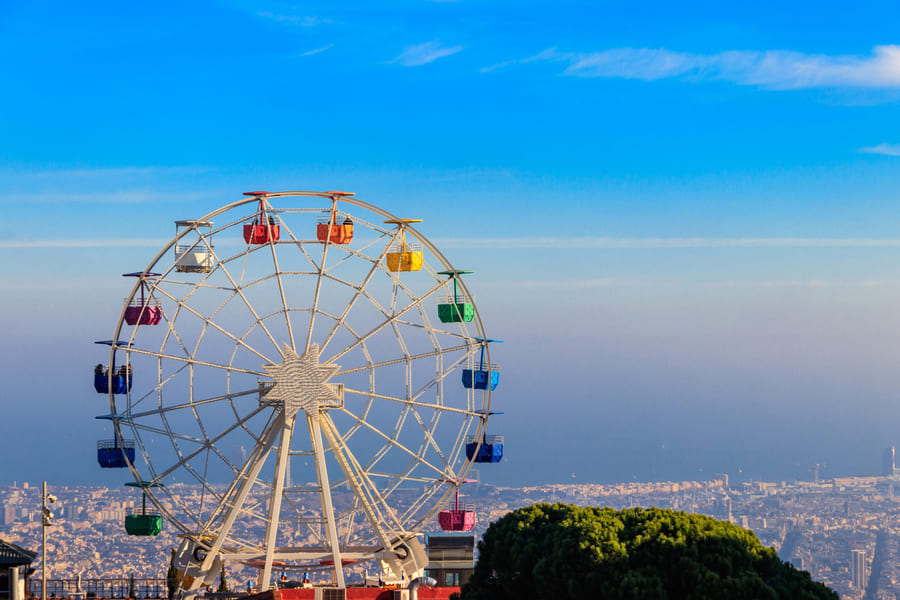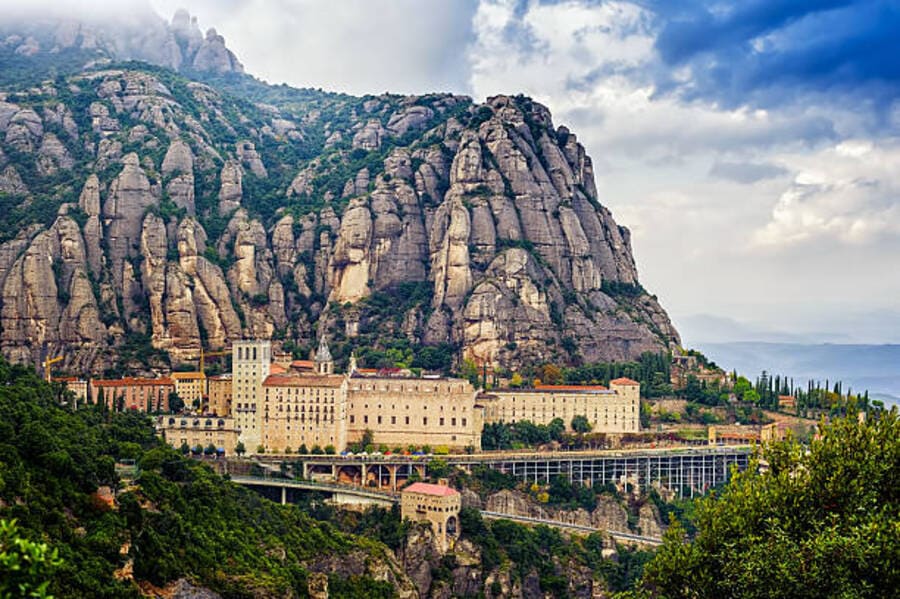Catalonia has a lot of mountains due to its location in the northeast of Spain, close to the Pyrenees.
These mountains offer beautiful natural landscapes and a wide range of outdoor activities for nature lovers and mountain sports enthusiasts.
Some of the best known mountains in Catalonia, Montjuic and Tibidabo in the province of Barcelona.
Montjuic past and present
The rocky promontory of Montjuic has also featured in some of the key events in Barcelona’s history..

A pre-Roman civilisation made a settlement here, preferring its rough heights to the humid plain that the Romans later opted for.
The Romans did, however, build a temple to Jupiter here, which is thought to explain the origin of the name: Mons lovis eventually evolved into Montiuïc.

How to get to Montjuic
There are different ways to get to Montjuic:
- Metro: Espanya (lines 1 red and 3 green) then you can reach it on foot for about 15 minutes, depending on where on the mountain.
- Montjuïc Funicular: Access metro Paral-lel (lines 2 and 3) and walk about 10 minutes.
- Buses: lines 13 and 125 as well as other buses with stops nearby such as 50, 55, 61 and 193 and of course with the Bus Turístic.
In Montjuïc you can practise a lot of types of tourism because the hill has got different interest points:
The Montjuïc Cable Car
The Montjuïc Cable Car leads you directly to the mountain of Montjuïc, an Olympic enclave full of history and symbolism.
This transport runs 750 meters to the top of the mountain with cabins adapted for people with reduced mobility, modern, safe and comfortable.
Relax and discover Barcelona from the air.
Poble Espanyol
Built in 1929 for the International Exhibition, Poble Espanyol was created from the desire to concentrate the spanish culture in a single space.
Today most of its constructions remain intact and are reproductions of buildings, squares and streets of different regions of Spain.
Walking through Poble Espanyol you’ll discover not only buildings, but also artisans, as well as viewing pieces of art by Dalí, Picasso or Miró.
You can do a lot of activities that Poble Espanyol offers like shows, music, cuisine, … Also you can visit shops, bars and restaurants which are open 365 days a year.
Poble Espanyol has everything you need to enjoy, on your own or in company, a day in the open air in unbeatable surroundings, without leaving Barcelona.
Castle of Montjuïc.
Montjuïc’s castle is an old military fortress dated in 1640. Is built on top of the hill. It currently serves as a Barcelona municipal facility.
The botanic garden.
We should know that this garden is in fact almost a forest. You will have the chance of doing a lot of activities: walk around the gardens, spend the day with family and kids, see the different types of birds and other animals, etc.
The Magic Fountain.
The fountain was built for the 1929 Barcelona International Exposition. In summer, you cannot miss the light and sound show.
The Olympic Stadium Lluís Companys.
The Stadium Lluís Companys also was built for the 1929 Barcelona International Exposition. However, it was renovated in 1992 for the Olympic Games.
Nowadays it welcomes both football and rugby games.
Good restaurants in the Montjuic Hill.
As other European countries such as Italy and France, Spain is one of the most famous countries as far as cooking is concerned, because of all the specialties they offer.
Once you get the hill you should go to the restaurant La Font del Gat in order to enjoy some real Spanish food in a real Spanish atmosphere.
The Foundation Joan Miró.
The Joan Miró Foundation is a cultural institution in Barcelona that keeps some of the most representative works of this Catalan painter. It contains more than 104.000 pieces between paintings, sculptures and tapestries.
The cemetery of Montjuïc
This cemetery was built in the middle of the nineteenth century.
You will find the most famous tombstones of Catalonia , such as the Catalan president Lluís Companys, the painter Joan Miró, writer Santiago Rusiñol or the first president of FC Barcelona Joan Gamper.
Park of Poble-sec.
Is one of the most charismatic parks of Barcelona, located on the mountain, with views to the sea.
It’s a very popular park because has got a children’s area and some space for dogs.
Safety tips to visit the hill
There are some safety tips to visit Montjuic and the city of Barcelona:
- Be careful where you put your valuables. Internal pockets are better than external ones. If you do need to put things in external pockets, try to keep your hands over them so you can feel where your valuables are.
- Do not carry a backpack on your back. You should be aware to this in the metro. If you have a backpack, put it in front of you.
- Thieves work in pairs or groups, so be careful when you are in places with a lot of people.
- Watch out for the classic tricks. These include: asking for change, asking for directions, someone ‘helping’ you with your bags and tricks such as the cup-and-ball game.
- Don’t leave your mobile on the table. Or your bag under the table. Or anything out of sight for an instant.
- There’s some thieves posing as tourists and operating on Metro and bus. So keep your valuables with you.
- Spain is a relatively safe country, but you should always be careful of thieves, especially in touristy areas. Keep your money in inside pockets.
- Keep safe your valuables and your trip to Barcelona will be calm and safe.
Tibidabo
Tibidabo is a famous mountain in Barcelona, Spain, known for its beautiful views of the city and the Mediterranean Sea.
It stands at an elevation of 512 meters (1,680 feet) and is part of the Serra de Collserola natural park.
Look no further than Tibidabo, the enchanting mountain that offers stunning views, thrilling rides, and endless excitement for visitors of all ages.
From the moment you step foot on Tibidabo, you’ll be captivated by its majestic beauty and the breathtaking panoramic views it offers.

At the summit of Tibidabo, you will find the iconic Sagrat Cor Church, which boasts stunning architecture and serves as a prominent landmark in Barcelona. The church is dedicated to the Sacred Heart of Jesus and has become a popular spot for visitors seeking panoramic views of the city.
Aside from the church, Tibidabo is also home to an amusement park called Parc d’Atraccions Tibidabo.
This century-old amusement park features a variety of rides and attractions for visitors of all ages. From thrilling roller coasters to classic carousels, there is something for everyone to enjoy.
Additionally, Tibidabo offers several hiking trails and picnic areas for those who prefer to explore the natural beauty of the mountain
Tibidabo Funicular
- Route: Lower Funicular Station (Plaça Doctor Andreu) – Tibidabo Amusement Park.
TibiBus T2B (from Parking B:SM Sant Genís)
- Route: Parking B:SM Sant Genís (in front of the Vall d’Hebron hospital complex) – Lower Station of the Funicular (Plaça Doctor Andreu).
AMUSEMENT PARK
Open:
- March, April and May: weekends, holidays and April 5-10.
- June: weekends and holidays. From June 23, Wednesday to Sunday.
- July and August: Wednesday to Sunday and holidays.
- September, October and November: weekends and holidays, 1 September and 13
- December: weekends and December 6, 7, 8, 22, 27, 28, 28 and 29.
- January: January 2, 3, 4 and 5.
PANORAMIC AREA
Open:
- February: weekends.
- March to December: every day (except December 25 and 26).
- January: January 2, 3, 4 and 5.
The Panoramic Area is free access. You can go up to the most emblematic attractions by buying the unlimited rides bracelet.
Attractions:
Enjoy the most emblematic attractions of Tibidabo from the highest point of Barcelona and contemplate the best views of the city.
Giradabo

Tibidabo’s most notable attraction is its iconic Ferris wheel, which allows visitors to soar above the city and take in spectacular vistas of Barcelona.
From the top of the Ferris wheel, you’ll witness a mesmerizing blend of urban cityscapes and natural landscapes that will leave you in awe
of Barcelona’s beauty.
But the Ferris wheel is not just a means of transportation; it is an experience that adds a touch of magic to your adventure at Tibidabo.
Talaia
The highest point of the city
Since 1921, the Talaia offers a 360° panoramic view of the city, 550 meters above sea level.
Height restrictions:
- You can climb: +120 cm
- You can climb with a companion: 80-120 cm
PLANE
FLYING OVER BARCELONA SINCE 192
The most emblematic attraction of the Park, the first flight simulator in history and replica of the first plane that made the Barcelona – Madrid flight in 1927
CAROUSEL
A vintage carousel that transports you to a world of fantasy.
Inaugurated in 1989 and located at the entrance of the Park, the Carousel is one of the classic attractions of Tibidabo.
MUSEUM OF AUTOMATONS
A UNIQUE MUSEUM RECOGNIZED WORLDWIDE
Collection of automatons, models and recreational games with more than 40 original pieces from the late 19th to the 20th century.
Restaurants & Shopping
Snacks and shopping at the top of the Tibidabo Hill
Here you will find the bars, restaurants and shops of the Tibidabo Panoramic Area, where you can have a snack with the best views of Barcelona.
Restaurants open on weekends and holidays. The Quiosc del Club dels Aventurers open every day.
In short, it is a place in Barcelona, where you can spend the day with several options to choose from, connected with nature.
Montserrat
Montserrat, an open-air museum.

Montserrat is a unique mountain in the world. A place not only spectacular from a geological point of view, but also because there is a Benedictine monastery with nearly a thousand years of history.
The monks of Montserrat dedicate their lives to work and prayer, they take care of the sanctuary of the Virgin and the reception of pilgrims and visitors.
In Montserrat, in addition to the acts of worship that are celebrated daily in the basilica, we will find a wide cultural offer and interesting tours through the mountain that will show us the natural wealth of this exceptional mountai.
Nature
The idea of time that we have most assumed and with which we usually move is a scale ranging from one year to a few thousand years, which allows us to understand our own history. In geology, this represents only a whisper in the history of the Earth and for this reason a more appropriate unit of time is used, in millions of years. Of the approximately 3,760 million years of geological record of the Earth, in the territory of Central Catalonia, where the Montserrat massif is located, part of the last 50 million years are represented.
Fauna
As a consequence of human pressure around the mountain, a situation that worsened with the major fire of 1986, the fauna began a process of decline, more pronounced in the large fauna.
Currently, the species that can be found, in general, are typically Mediterranean.
The imposing forms of the Montserrat massif rise in the heart of the province of Barcelona, in the midst of a landscape of mountains with smooth profiles and eroded by the passage of time.
eroded by the passage of time.
The origins
We have seen the hermit origin of the Christian life really in Montserrat, and how this is consolidated in them during the time of the count of Barcelona
Guifré el Pilós group (840-897). In the year 888 we find the first documented mention of Montserrat.
The monastery today
Montserrat continues its historical itinerary and is preparing to celebrate the millennium of its foundation as a monastery in 2025.
The present community, made up of about sixty monks, is dedicated, as in the past, to a life of prayer, work and welcoming the thousands of pilgrims who come to the Sanctuary

The liturgy marks the daily rhythm of the monastic day; with it the day begins and ends.
Every day the monks gather six times to celebrate the Liturgy of the Hours and the celebration of the Eucharist, which is the central act of the day in the monastery and in the sanctuary. Many pilgrims participate.
The community carries out an extensive pastoral work, which takes the form of services in the basilica, the reception of groups, recesses and conferences, and the care of the guest house.
The sanctuary
The presence of the holy image.
The singularity and special beauty of the mountain of Montserrat, with its majestic spires that rise towards the sky, make it a chosen place for the manifestation of the presence of the religious fact. With full certainty that the monks who arrived in the eleventh century felt the call of this sacred place and began the care and custody of the sanctuary dedicated to Santa Maria.
The maximum expression of this devotion is manifested with the holy image of the Virgin of Montserrat, venerated throughout the centuries and popularly known by the name of Moreneta because of its dark color.
The image of Santa Maria de Montserrat is a Romanesque carving of polychrome and gilded wood, from the late eleventh century, although the hands of the Virgin and the child Jesus had to be repaired in the mid-nineteenth century, as a result of the devastation caused during the French War (1811-1812).
The Escolania of Montserrat
The origin of the Escolania is to be found in the educational vocation of religious institutions since medieval times; the Escolania de Montserrat is already documented in the 13th century.
The colleges of canons in the cathedrals and the communities of monks in the monasteries exercised an educational task in the society of the time; in the case of the monks, the essential presence of chant and music in their liturgy explains the specialization in musical schools.
In this context we can understand the children’s choir of Montserrat, although the fact that it has had continuity until the present day makes it a unique case; we can speak of one of the oldest music schools in Europe.
The basilica
The atrium
This space is delimited by the building of the abbot Benet Argerich built in the 18th century, intended as a dwelling for the monks, which we can now see from the inside.
It is articulated around two cloisters arranged in front of the church and following its axis.
This work meant a great improvement in the monastery, since it meant spacious cloisters in front of the church that perform the function of an atrium, and six floors of rooms for the monks in the southern wing.
The construction of the new church
Work on the present church began in 1560 and was consecrated in 1592; it is a project linked to the abbot Bartomeu Garriga (1559-1562; 1568-1570).
1570).
It occupies a space that was initially intended to be used for the monastery, but ended up being used for the new church due to the need to replace the old Romanesque church, which had become insufficient to accommodate the numerous faithful and also for the needs of the monastic offices.
Abad Oliba Square
This square, for many centuries, played a central role, as it is the point of arrival of the road to Sant Miquel where pilgrims arrived on foot. Until a few years ago, the peasants sold their products, for this reason it is still known among many people as the “Plaça de les Pageses”.
Today it is surrounded by three cell buildings designed to accommodate visitors.
At the top of the stairs, known as “Stairs of the poor” (beginning of the route to Sant Jeroni, by the Pla dels Ocells), we find a sculpture dedicated to the founding abbot, which gives its name to the square. It is a work of Manuel Cusachs from 1992.
The Museum of Montserrat
It occupies all the space under the surface of the three squares in front of the monastery, which were also built by the architect Josep Puig i Cadafalch, within an integral project of architectural and urban reform of Montserrat, between the years 1929 and 1933.
The first thing the visitor sees is the large lobby, where the store and ticket sales are located; it is structured with pillars that divide the space into twelve sections covered with Catalan vaulting, originally a space dedicated to washing and drying rooms, as well as a residence for the sanctuary’s staff. The building that houses the museum’s permanent exhibition is of great architectural interest due to its unique structure.
Otras montañas
Pedraforca mountain, in the Berguedà region, known for its distinctive forked shape; and Aigüestortes i Estany de Sant Maurici National Park, in the Pallars Sobirà region, which boasts impressive lake and mountain landscapes.






